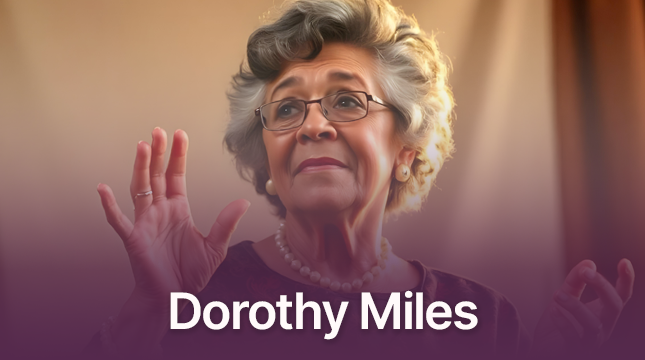Dorothy Miles, affectionately known as “Dot,” was a pioneer in the world of sign language poetry and an influential activist within the Deaf community. Born in 1931 in Wales, she became deaf at an early age, yet she grew to become a dynamic force in both British and American Deaf cultures. Her unique approach to poetry, combining British Sign Language (BSL) and American Sign Language (ASL) with English, created an expressive bridge that spoke to both Deaf and hearing audiences about themes like identity, resilience, and social justice.
Early Life and Deaf Identity
Dorothy Miles lost her hearing as a child, which played a pivotal role in shaping her perspective and creative path. As she grew older, she became fluent in English, BSL, and ASL. Through her use of these languages, she discovered that sign language was not just a means of communication but also a medium for artistic expression. Her poetry delved deeply into what it meant to be Deaf, exploring the intricacies of identity and the societal challenges faced by Deaf individuals.
Miles’ Contributions to the Deaf Community
Dorothy Miles made groundbreaking contributions to the Deaf community. In the United States, she helped establish the National Theatre of the Deaf, a vital institution that brought sign language and Deaf culture to wider audiences. She was instrumental in promoting Deaf representation, helping audiences appreciate Deaf experiences, and paving the way for other Deaf artists to share their stories.
Her impact was equally profound in the UK, where she was a foundational figure in the development of BSL poetry. She advocated for the recognition of sign language as an artistic and literary form, and her work inspired a generation of Deaf poets and performers. Miles’ contributions continue to be a cornerstone in the ongoing efforts to promote the rights and inclusion of Deaf individuals.
Dorothy Miles’ Poetry and Themes
Dorothy Miles’ poetry is celebrated for its bold and honest portrayal of life in the Deaf community. She often used her work to challenge stereotypes and bring awareness to issues of social justice. Her poems, which often combined sign language and written English, touched on themes such as:
- Identity and Self-Acceptance: Miles’ poetry explored what it meant to be Deaf and the journey of embracing one’s identity.
- Disability and Society: She highlighted the barriers Deaf individuals face in accessing education, employment, and fair treatment.
- Unity and Understanding: Miles’ work aimed to bridge the gap between Deaf and hearing communities by fostering empathy and mutual understanding.
Some of her most celebrated works continue to resonate today, offering insights into Deaf culture and inspiring both Deaf and hearing audiences.
Legacy and Influence of Dorothy Miles
Dorothy Miles passed away in 1993, but her legacy endures. Her pioneering work laid the groundwork for future generations of Deaf poets, performers, and activists. She not only created a new form of expression but also inspired others to advocate for Deaf rights and celebrate Deaf identity.
Her influence can be seen in the ongoing growth of Deaf literature, the establishment of sign language poetry as a respected art form, and the increasing visibility of Deaf issues worldwide. Her life’s work continues to inspire people to learn more about Deaf culture, advocate for inclusion, and celebrate the rich heritage of sign language.
FAQs About Dorothy Miles
1. Who was Dorothy Miles?
Dorothy Miles was a Deaf poet, activist, and pioneer of sign language poetry. She made significant contributions to the Deaf community in both the United States and the United Kingdom.
2. What was Dorothy Miles’ contribution to the Deaf community?
Miles helped establish the National Theatre of the Deaf, promoted BSL poetry in the UK, and advocated for the rights and inclusion of Deaf individuals.
3. What is sign language poetry?
Sign language poetry is a form of artistic expression that uses sign language to convey rhythm, emotion, and visual imagery, often in ways that written or spoken language cannot fully capture.
4. What are some of Dorothy Miles’ most famous poems?
Many of Dorothy Miles’ works delve into themes of Deaf identity, social justice, and resilience. While some of her poems are better known within the Deaf community, her influence remains far-reaching.
5. How can I learn more about Dorothy Miles’ work?
Dorothy Miles’ work can be explored through resources on Deaf history, publications that highlight her poetry, and institutions that honor her contributions to Deaf culture and sign language poetry.
Dorothy Miles was more than a poet; she was a beacon for the Deaf community, advocating for understanding and acceptance. Her life and work continue to inspire those within the Deaf community and beyond, ensuring that her voice remains a vital part of history and Deaf culture.

